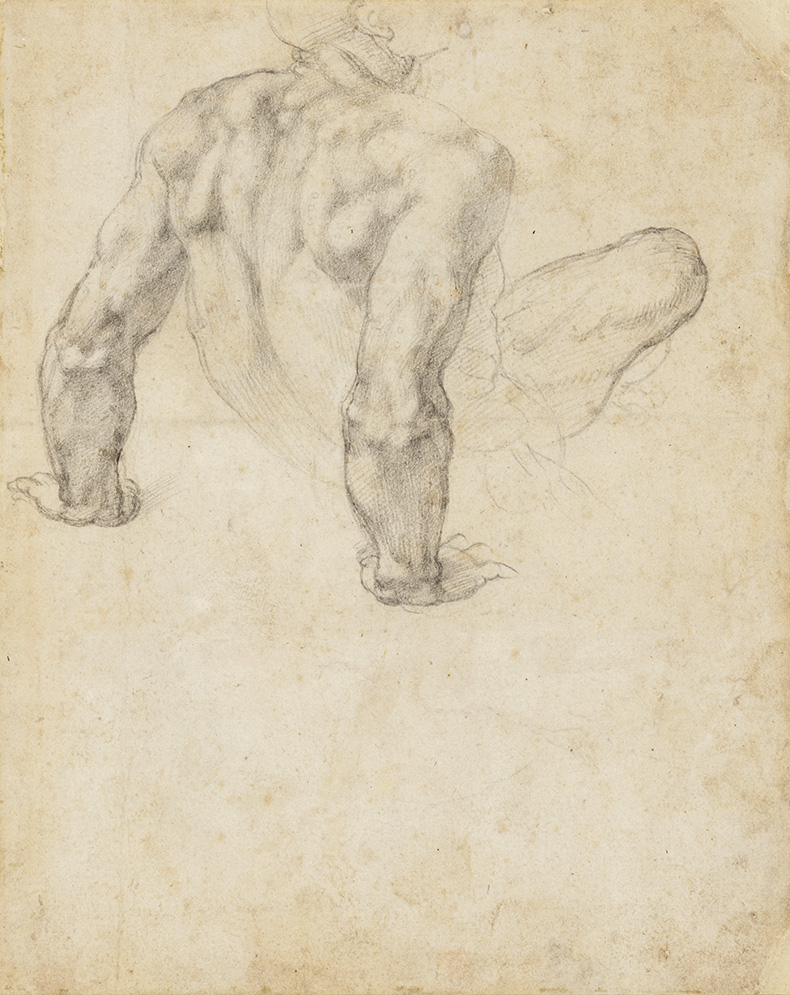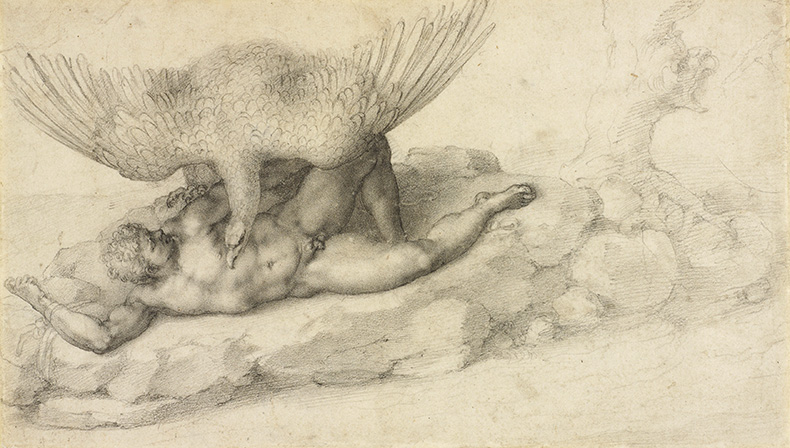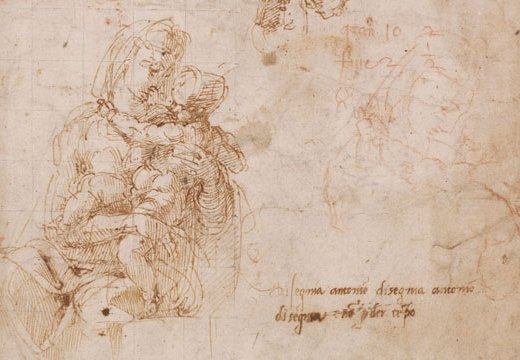From the June 2024 issue of Apollo. Preview and subscribe here.
Visitors to ‘the last decades’ come directly face to face with the master. A portrait drawing of Michelangelo by his acolyte and intimate friend Daniele da Volterra is the first work displayed. The drawing, made when Michelangelo was in his mid to late 70s, is a cartoon. It was pricked for transfer to paint the mural of the Assumption of the Virgin in the Della Rovere Chapel in the Roman church of Santissima Trinità dei Monti. In that picture, Michelangelo is at the (viewer’s) far right, among the apostles. His contemplative gaze is directed outwards. His right arm directs the beholder’s eyes towards the Virgin rising to heaven. The inclusion testifies to Michelangelo’s stature – ‘divine’ was an adjective used to describe him and his work – and the gesture to his devotional ardour. These and other aspects of his complex character are explored here through a compelling selection of his drawings and letters, poems in draft and polished form and prints and paintings after his designs, in an exhibition that charts the last third of his career.
Daniele was among those with Michelangelo when he died on 18 February 1564. He had written to the artist’s nephew and heir four days before, begging him to hasten from Florence to Rome. The letter, signed by Michelangelo with cramped and sloping hand, is among the last exhibits, a poignant testimony to Michelangelo’s failing, yet ever tenacious, grasp on life.
Thirty years earlier, on the eve of his departure from Florence to Rome, Michelangelo (then 59) wrote to one Febo di Poggio, a disaffected young man who was the object of his admiration, to say that he was never to return. Not for the first time Michelangelo left Florence more or less in secret and anxious for his safety. In this case he was in a dangerously compromised position, having played an active part in directing the city’s fortification in the Florentine Republic’s last stand against the Medici in 1529–30. But he was too famous and too long linked to the family, through his formative years in the household of Lorenzo the Magnificent and the patronage of Lorenzo’s son Giovanni and nephew Giulio (later popes Leo X and Clement VII), to be harmed or dismissed. He was forgiven by the latter, who was soon to commission him to paint the Last Judgment in the Sistine Chapel.

Study of a man rising for the Last Judgment (c. 1534–36), Michelangelo. British Museum, London. Photo: © The Trustees of the British Museum
Only a handful of drawings survive from the planning of that monumental drama which took seven years to complete (1534–41). A significant number of them are in the first room of the exhibition. A sheet from the Casa Buonarroti, for example, shows him visualising a swirling distribution of figural groups that would cover the wall in poses of hope and despair responding to Christ’s commanding gesture, which typically is propelled by the fulcrum of his powerful and slightly turned torso. Typically as well, and as is demonstrated in the exhibition, Christ’s position evolved from previous thoughts. A sketch of Christ in a similar pose was developed from a tracing on the back of a lovingly finished drawing of the giant Tityus with a vulture poised to feed on his liver (see p. 105). The Tityus is one of the mythologies given by the enamoured artist to the young and beautiful Tommaso de’ Cavalieri. Turned 90 degrees, the prone victim becomes the resurrected Saviour. This flip side transformation is an instance of Michelangelo’s imaginative process, along with his thrifty use of paper.
In the case of the Last Judgment drawing, light chalk marks suggest emerging forms, some resolved and shaped with darker outlines. Cross-hatching over the clouds of decision, or indecision, set the groups into relief. All of the figures in the compositional and the larger life studies are drawn nude, as was usual for Michelangelo. In the Last Judgment, however, they remain naked – a controversial choice that became a cause célèbre about artistic expression and religious decorum.
The dominance of black chalk as the medium for the Last Judgment studies is a striking feature of Michelangelo’s practice from the 1530s onwards. That his pen was to hand is demonstrated in the careful calligraphy of his letters and its use in architectural draughtsmanship, thoroughly represented in the exhibition. Perhaps he favoured black chalk for figure studies because it could be rubbed and also readily controlled to achieve different effects, from sharp lines to murky depths. Going from the polished, ivory-like surfaces evoked in the Christ on the Cross that Michelangelo presented to Vittoria Colonna for her spiritual meditations in around 1543 to the shadowy crucified Christs of his later contemplation of the Passion is proof of that versatility. Yet what explains the paucity of drawings for complex commissions? To what degree are the fragmentary (and often literally fragmented) remains of Michelangelo’s drawing practice simply the hardiest survivors of a long history? Or to what degree do they, at least in some part, represent the result of Michelangelo’s deliberate shaping of his reputation? As much as he suffered the indignity of growing old, Michelangelo was keenly aware that he was in a position to fashion his own legacy.

The Punishment of Tityus (1532), Michelangelo. Royal Collection Trust, London. Photo: © His Majesty King Charles III 2024
The exhibition offers a rare occasion to see how Michelangelo’s artistic, emotional and devotional life evolved in times of religious crisis and reform. It demonstrates how he was able to give spiritual conviction pictorial and poetic form. It shows how he answered constant demands for works by his hand and for his expertise with a strategic deployment of his talents as draughtsman and designer, correspondent and poet. Drawings, paintings and prints reveal his increasingly systematic delegation of the planning and execution of projects, from the production and replication of relatively small-scale devotional pictures to reconceiving and supervising the construction of St Peter’s Basilica. His creative impulses endured even as he complained that he could no longer draw a straight line or that he was so old that writing was a chore (so he told his nephew in June 1562 in a letter thanking him for the 43 flasks of Trebbiano wine sent from Florence). Michelangelo’s genius served him well while he grudgingly adapted to the infirmities of age, proving the prophetic truth of his own verses: ‘No one has mastery / before reaching the end / of his art and his life.’
‘Michelangelo: the last decades’ is at the British Museum until 28 July.
From the June 2024 issue of Apollo. Preview and subscribe here.














![Masterpiece [Re]discovery 2022. Photo: Ben Fisher Photography, courtesy of Masterpiece London](http://zephr.apollo-magazine.com/wp-content/uploads/2022/07/MPL2022_4263.jpg)
‘Like landscape, his objects seem to breathe’: Gordon Baldwin (1932–2025)